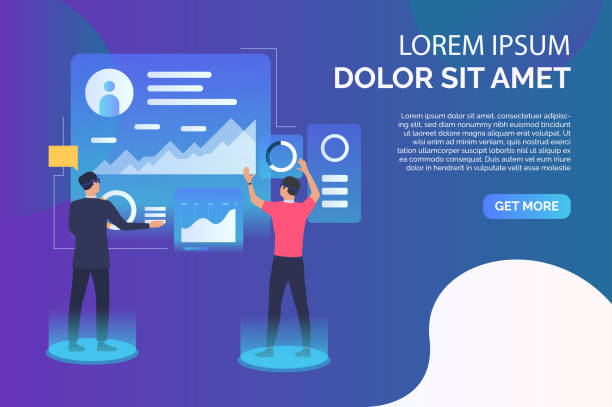Introduction to Responsive Website Design and Its Importance

In today’s world, where #internet has become an inseparable part of our daily lives, accessing information through #diverse_devices is a necessity.
From smartphones and tablets to laptops and smart TVs, users expect websites to provide an efficient and engaging experience on any screen size.
This is where the concept of responsive website design comes into play.
A responsive website literally “reacts”; its design intelligently adapts to the user’s screen size and device orientation to provide the best visual and interactive experience.
This approach not only offers numerous benefits for end-users but is also vital for business owners.
In the past, many companies developed two separate versions of their website: one for desktop and one for mobile.
This method was not only costly but also presented complexities in management and updates.
However, with the advent of responsive design, these challenges have largely been resolved.
The main goal of responsive design is to optimize the user experience (UX) on every device, without the need to develop multiple separate versions.
This concept has created a fundamental transformation in the web industry.
Do you know that your customers’ first impression of your company is your website? Multiply your business credibility with a powerful corporate site from Rasawb!
✅ Custom and eye-catching design tailored to your brand
✅ Improved user experience and increased customer attraction
⚡ Get a free consultation!
Key Benefits of Your Website Being Responsive

Adopting responsive website design is more than a fleeting trend; it is a strategic necessity for any business that wants to remain competitive in the online space.
One of the most prominent advantages of a responsive website is the significant improvement in user experience.
When users can easily navigate your website, view content without needing to zoom or scroll horizontally, and simply fill out forms, they are more likely to stay on the site and achieve their goal (such as purchasing, signing up, or reading content).
This directly affects the Bounce Rate and the user’s time spent on the site.
Another critical advantage is the positive impact on SEO.
Google and other search engines prioritize responsive websites and rank them higher in search results, especially for mobile searches.
A single URL for all devices means easier SEO management and avoids duplicate content that can harm site rankings.
Furthermore, managing responsive websites is simpler and more cost-effective.
Instead of maintaining and updating multiple separate versions, there is only one codebase that needs maintenance.
This not only reduces development and maintenance costs but also speeds up the process of updating and adding new content.
Also, a responsive website can lead to an increase in Conversion Rate, as users can easily access your products and services from any device and complete the purchase process.
Technical Principles of Responsive Design

To deeply understand responsive website design, we need to be familiar with its technical principles.
The foundation of responsive design rests on three main pillars: Flexible Grids, Flexible Images, and Media Queries.
Flexible grids use relative units like percentages for element widths instead of fixed pixel units.
This approach ensures that the website layout changes proportionally with screen size.
For example, a column that is 300 pixels wide on a desktop might occupy 30% of the screen width in responsive design.
Flexible images also work similarly; by using CSS properties like `max-width: 100%`, it is ensured that images never exceed the width of their container and automatically scale to fit the available space.
This prevents layout issues and unwanted horizontal scrolling.
However, the main element that makes responsive design magic possible is Media Queries.
Media Queries are conditional CSS rules that allow the browser to apply specific styles only if certain conditions (such as screen width, device type, or orientation) are met.
For example, a different style can be defined for website navigation at smaller sizes, displayed as a hamburger menu instead of a horizontal bar.
Here is an example of common breakpoints for responsive website design:
| Screen Width (pixels) | Device Type (approx.) | Design Approach |
|---|---|---|
| Less than 576px | Small Mobile Phone | Single-column layout, collapsible navigation menu |
| 576px to 768px | Large Mobile Phone / Small Tablet | Single or two-column layout, larger font sizes |
| 768px to 992px | Tablet / Small Laptop | Two or three-column layout, more flexible arrangement |
| 992px to 1200px | Laptop / Medium Desktop | Three or four-column layout, standard desktop layout |
| More than 1200px | Large Desktop | Layout optimized for wide displays |
These principles together allow designers to provide fully optimized user experiences across a wide range of devices.
Common Tools and Frameworks

To facilitate the process of responsive website design, developers have access to a set of tools and frameworks, each with its own advantages and features.
One of the most popular and widely used frameworks is Bootstrap.
Bootstrap is a powerful and free front-end framework that provides a collection of HTML, CSS, and JavaScript tools for developing responsive and mobile-first websites.
Using Bootstrap’s 12-column Grid System, complex and responsive layouts can be created quickly.
Another framework with its own advocates is Tailwind CSS.
Unlike Bootstrap, which comes with pre-built components, Tailwind is a Utility-First framework.
This means that Tailwind offers a wide range of single-purpose CSS classes that can be used directly in HTML to style elements.
This approach provides high flexibility for custom designs but may have a steeper initial learning curve.
Alongside CSS frameworks, browser developer tools (such as Chrome DevTools or Firefox Developer Tools) play a vital role in the design and debugging process.
Using these tools, websites can be simulated at different screen sizes and their responsiveness observed in real-time.
Also, tools like Figma or Sketch are very useful for initial UI/UX design and creating responsive prototypes before entering the coding phase.
These tools allow designers to plan and visualize the user experience across different dimensions.
Proper use of these tools can accelerate and optimize the responsive design process and help developers deliver high-quality and excellent performing websites.
Do you dream of a thriving online store but don’t know where to start?
Rasawb is your comprehensive e-commerce website design solution.
✅ Attractive and user-friendly design
✅ Increased sales and revenue⚡ Get a free consultation
User Experience and Responsive Design

Responsive website design is not just about resizing visual elements; it is a comprehensive approach to improving user experience (UX) across all devices.
In fact, the main goal of this design is to ensure that users, regardless of the device they use, can easily interact with the website and access the information they need.
This includes optimizing content readability, ease of navigation, and form efficiency.
For example, on a small screen, it may be necessary to increase font and line sizes to improve readability, or enlarge buttons and links to make them easier to tap with fingers.
Another crucial aspect is compatibility with different inputs.
While desktop users use a mouse and keyboard, mobile users primarily use touchscreens.
A responsive website must consider these differences and ensure that interactive elements are optimized for both types of input.
This includes designing touch-friendly buttons, avoiding small and closely spaced elements, and implementing appropriate gestures.
Also, page loading speed is an important factor in user experience, especially on mobile devices that may have weaker internet connections.
Responsive design can help increase site speed by optimizing images, reducing unnecessary code, and using efficient loading techniques.
This comprehensive approach to design leads to an intuitive and enjoyable user interface that encourages users to spend more time on the website and become loyal customers.
Responsive Website Design and SEO

The connection between responsive website design and SEO is very deep and vital.
In fact, Google officially announced in 2015 that responsiveness is a ranking factor for mobile searches, and this importance has grown over time.
Today, with Google’s Mobile-First Indexing approach, your website’s mobile version becomes the primary basis for content indexing and ranking by the search engine.
This means that if your website is not optimized for mobile, regardless of the quality of your desktop content, it will likely not rank well in search results.
One of the main reasons Google prefers responsive websites is a better user experience.
When users can easily navigate your site and read content on any device, the bounce rate decreases, and user dwell time increases; these signals are considered positive by search engines.
Furthermore, having only one URL for all device versions (instead of separate m.site.com versions) helps prevent duplicate content issues and search engine confusion and simplifies backlink and SEO management.
Also, page loading speed, which is an important SEO ranking factor, can be improved with responsive design.
By optimizing images and CSS/JS codes for different devices, unnecessary resource loading on mobile devices can be prevented, and site speed can be increased.
Ultimately, a responsive website helps you reach a wider audience, as users from various devices (from smartphones to smart TVs) can easily access your content and interact effectively, which significantly contributes to improving SEO and online visibility.
Implementation Challenges and Solutions

Implementing responsive website design, despite its many advantages, is not without challenges.
One of the first challenges is the complexity of initial design and development.
Designing for multiple screen sizes simultaneously requires deeper thought about layout, content flow, and interactive elements.
This can increase the initial development time and cost compared to a static design.
The solution to this challenge is “mobile-first” design; first design the layout for the smallest screen and then gradually expand it for larger screens.
This approach ensures that the primary user experience is optimized for mobile devices, which constitute the majority of users.
Another challenge is content and image management.
Large images can severely reduce site loading speed on mobile devices.
For this problem, using Responsive Images, which load optimized versions of an image based on screen size or device resolution, is an effective solution.
Also, lazy loading techniques can be used for images outside the viewport.
Overall site loading speed is also a major concern.
To solve this problem, in addition to image optimization, attention should be paid to minimizing CSS and JavaScript files, using a CDN (Content Delivery Network), and enabling browser caching.
The following table shows some common challenges and their corresponding solutions:
| Challenge | Description | Solution |
|---|---|---|
| Initial design complexity | Need to consider multiple display states | Mobile-first approach, use of frameworks |
| Large image management | Reduced loading speed on mobile | Responsive images, Lazy Loading, web-optimized formats |
| Slow loading speed | Negative effect on UX and SEO | Code optimization, compression, CDN, caching |
| Difficulty in mobile navigation | Limited space for menus and links | Hamburger menu, dropdown menus, sticky navigation |
| Browser incompatibility | Different display in older browsers | Use of Polyfills, thorough testing in different browsers |
By understanding these challenges and applying appropriate solutions, an excellent performing responsive website with a seamless user experience can be created.
The Future of Web Design and Responsiveness

The future of responsive website design will not only continue its evolution but its importance will become even more apparent with the emergence of new technologies.
With the increasing diversity of internet-connected devices, from smartwatches to virtual and augmented reality, the need for flexibility in content display has become an absolute necessity.
Optimizing only for mobile and desktop is no longer sufficient; designers must think about delivering content on non-traditional screens and new interactions.
One of the key trends in the future is Content-first Design.
Instead of placing content within a predefined design framework, the design should be shaped around the content and provide the necessary flexibility for content display on any device.
This approach gains even more importance, especially with the expansion of the Internet of Things (IoT) and the need to display information on devices with different capabilities.
Also, advances in CSS and JavaScript will provide more powerful tools for developers.
Features like Container Queries (which allow elements to react based on their container size, not just the overall Viewport), Type Queries, and Subgrid in CSS provide greater flexibility for creating complex and responsive layouts.
In addition, given the increasing importance of Accessibility, responsive design will play a significant role in ensuring the accessibility of websites for all users, including individuals with disabilities.
Optimization for voice inputs, motion controls, and assistive technologies will be an integral part of a forward-looking responsive design.
Finally, the focus on Performance of websites will also continue; as users expect content to load immediately, regardless of network connection or the device they are using.
Are you tired of losing business opportunities due to not having a professional corporate website?
Rasawb helps you with professional corporate website design:
✅ Build a powerful and reliable image for your brand
✅ Convert website visitors into loyal customers
⚡ Get a free consultation right now!
Successful Design Case Study

To better understand the effectiveness of responsive website design, examining a successful case study can be very informative.
One of the best examples is The Boston Globe website, which was one of the first and most prominent news websites to fully adhere to responsive design principles.
Before implementing responsive design, this website faced challenges in providing a consistent user experience across different devices.
Mobile users had to zoom in and scroll horizontally to read news, which led to an unpleasant experience and a high bounce rate.
The Boston Globe design team, in collaboration with companies like Happy Cog, adopted a “mobile-first” approach.
They first optimized the layout and content for the smallest screen and then gradually expanded it for larger screens.
This involved using flexible grids, flexible images, and advanced media queries.
The result was a website that was seamlessly viewable and interactive on any device, from smartphones to smart TVs.
Implementing this approach not only significantly improved the user experience but also had a positive impact on SEO and website traffic.
Mobile traffic increased significantly, and users spent more time on the site.
This success inspired many other news organizations and large businesses to adopt a similar approach.
This case study shows that responsive design is more than a cosmetic change; it is a comprehensive strategy that can directly impact business success in the digital space.
The success of this website in optimizing for all devices was due to careful attention to design details and user experience at every screen size.
Importance of Loading Speed and Optimization

One of the critical elements in the success of any website, especially those that benefit from responsive website design, is page loading speed.
In today’s world, where users have high expectations for website performance, even a few milliseconds of delay in loading can lead to losing visitors and decreasing conversion rates.
Google also considers loading speed as an important ranking factor in SEO, as it directly affects user experience.
To ensure optimal speed on a responsive website, special attention must be paid to several aspects.
The first and most important is image optimization.
Large, high-resolution images can consume a significant amount of bandwidth and severely increase loading time.
Using modern image formats like WebP, compressing images without sacrificing quality, and implementing lazy loading for images not initially visible on the page are effective solutions.
In addition to images, reducing the size of CSS and JavaScript files is also important.
This can be achieved by removing unnecessary code, minification, and combining files.
Also, using Content Delivery Networks (CDN) can significantly increase loading speed by serving content from the nearest server to the user.
Enabling Browser Caching also causes the user’s browser to store some site resources for subsequent visits, thereby reducing loading time for repeat visits.
Finally, choosing a powerful and optimized hosting for the website also significantly impacts its overall speed.
Paying attention to these points ensures that your responsive website is not only beautiful and user-friendly but also loads in the shortest possible time, providing an unparalleled user experience.
Frequently Asked Questions
| Question | Answer |
|---|---|
| What is Responsive Web Design? | It is a method of website design that optimizes the appearance and functionality of the website according to the screen size of the user’s device (mobile, tablet, laptop, etc.). |
| Why is responsive design important? | Due to the increasing use of various devices to access the internet, responsive design provides a better user experience, improves site SEO, and reduces maintenance costs. |
| What are the most important responsive design tools? | Media Queries in CSS, use of relative units (such as percentage, em, rem, vw, vh), Flexible Images, and Grid Systems. |
| What role do Media Queries play in responsive design? | Media Queries allow different CSS styles to be applied based on device characteristics (such as screen width, height, orientation, and screen type). |
| What is the Mobile First concept in responsive design? | It is an approach where design and development begin for the smallest screen (mobile) and then gradually expand for larger screens (tablet, desktop). |
| Does responsive design affect site SEO? | Yes, Google prefers responsive websites because they offer a better user experience and eliminate the need for separate mobile and desktop versions, which helps improve SEO ranking. |
| What does Fluid Layout mean? | It means that the width of page elements is defined using relative units (such as percentages) instead of fixed pixel values, so that they automatically adjust when the screen size changes. |
| How are Flexible Images used in responsive design? | By setting the `max-width: 100%;` property for images in CSS, it is ensured that the image never becomes larger than its container and its scale is maintained when the screen size changes. |
| What are the differences between responsive design and adaptive design? | Responsive design uses a single layout that fluidly adapts to any screen size, while adaptive design uses several fixed, predefined layouts for specific screen sizes. |
| Are CSS frameworks like Bootstrap useful in responsive design? | Yes, frameworks like Bootstrap have a responsive Grid System and pre-designed components that make the process of building responsive websites much simpler and faster. |
And other advertising services by Rasawb Advertising Agency
Smart Custom Software: Professional optimization for increased website traffic using Google Ads management.
Smart Marketing Automation: Professional optimization for increased click-through rates using attractive user interface design.
Smart Digital Advertising: A quick and efficient solution for online growth focusing on custom programming.
Smart Advertorials: A specialized service for online growth based on attractive user interface design.
Smart Customer Journey Map: A specialized service for increased website traffic based on intelligent data analysis.
And over hundreds of other services in the field of internet advertising, advertising consultation, and organizational solutions
Internet Advertising | Advertising Strategy | Advertorial
Resources
Resources:
- Importance of Responsive Design in Websites
- Challenges of Responsive Website Design
- Web Development in the Digital Age
- The Future of Web Design and Responsiveness
? Looking to grow and be seen in the digital world? Rasawb Afarin Digital Marketing Agency, relying on up-to-date knowledge and extensive experience in user-friendly website design and implementing effective online marketing strategies, is always ready to help you achieve great successes.
📍 Tehran, Mirdamad Street, next to Bank Markazi, Kazeroun Jonoubi Alley, Ramin Alley, No. 6


